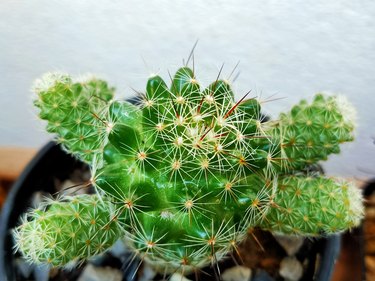
Cacti, members of the Cactaceae family, have a wide range of growth patterns, from slow to fast. To make a cactus grow faster, you must provide an ideal growth environment with the optimal soil, light, temperature, water and fertilizer. When growth slows, consider repotting the cactus into a larger container. With more than 1,750 species that thrive in U.S. Department of Agriculture plant hardiness zones 3 through 12 depending on species and cultivars, you can find a cactus for any home or garden whether you live in the desert or tropics.
Plant on Well-Draining Soil
Video of the Day
The cactus family is primarily native to the Americas plus some that are found in Africa, Madagascar and Sri Lanka. Whether a desert or tropical species, your cactus needs to grow on a well-draining location in your garden or a quick-draining potting mix formulated for cacti and succulents when planted in a container.
Video of the Day
If you prefer to mix your own potting soil, combine one part perlite or pumice with two parts coarse sand and three parts all-purpose potting soil or compost to make a loose, quick-draining mix for desert cacti and other succulents. Tropical cacti, such as the holiday cactus (Schlumbergera spp.) and mistletoe cactus (Rhipsalis baccifera), hardy in USDA zones 9 or 10 through 12, prefer more organic matter around their roots, such as equal parts peat moss or coconut coir, compost and coarse sand or perlite.
Keep It Warm and Bright
While the brittle prickly-pear cactus (Opuntia fragilis), hardy in USDA zones 3 or 4 through 10, tolerates temperature extremes, most cacti prefer warmer temperatures. Each species has a specific temperature range, but in general, keep your desert cactus at 45 to 55 degrees Fahrenheit in winter. In summer, keep it between 65 and 85 degrees during the day and reduce temperatures to the 60s at night.
Your tropical cactus prefers temperatures between 70 and 80 degrees from late spring through early fall and between 60 and 68 degrees in fall. You can let temperatures drop to 50 to 59 degrees at night to encourage the plant to set flowers for holiday blooming, but the colder temperatures will also slow the growth of its stem segments.
Adjust the light levels according to the original habitat of your cactus. Desert species usually need direct sunlight to encourage speedy growth. A tropical cactus needs bright, filtered light for best growth. Both types enjoy a summer vacation in the garden; put the cactus in light or dappled shade and then move the desert species into direct sunlight after it acclimates to the brighter outdoor light.
Add Water and Fertilizer
To make a cactus grow faster, water your desert cactus when the soil is dry. Drench the potting mix until water drains from the bottom of the flowerpot. Let it drain completely and then allow the soil to dry before watering again.
Tropical cacti should never be allowed to dry out completely. Wait to water until the soil is dry to the touch and then water it. Whether desert or tropical, never allow your cactus to stand in water. Remove water from the saucer under the pot immediately.
Fertilize with a fertilizer formulated specifically for cacti and succulents when the plant is actively growing from late winter through summer. Alternatively, fertilize a tropical cactus monthly with a 20-20-20 liquid fertilizer diluted to half strength. When temperatures begin to cool and growth slows, stop fertilizing.
Repot When Growth Slows
When a cactus plant's growth slows, it may be time to repot. Don safety glasses, thornproof gloves, a dust mask and other safety gear. Wrap the cactus with several layers of newspaper to protect your hands as well as the spines before gently removing it from the flowerpot.
Examine the root ball and trim damaged or rotting roots with scissors or pruners that have been sterilized with rubbing alcohol. Unwind any roots that wrap around the root ball and trim as needed. Dust with a fungicide and then replant in fresh cactus potting mix. Wait for a week before watering the cactus; the root ends need time to recover before being exposed to moist soil and potential pathogens.